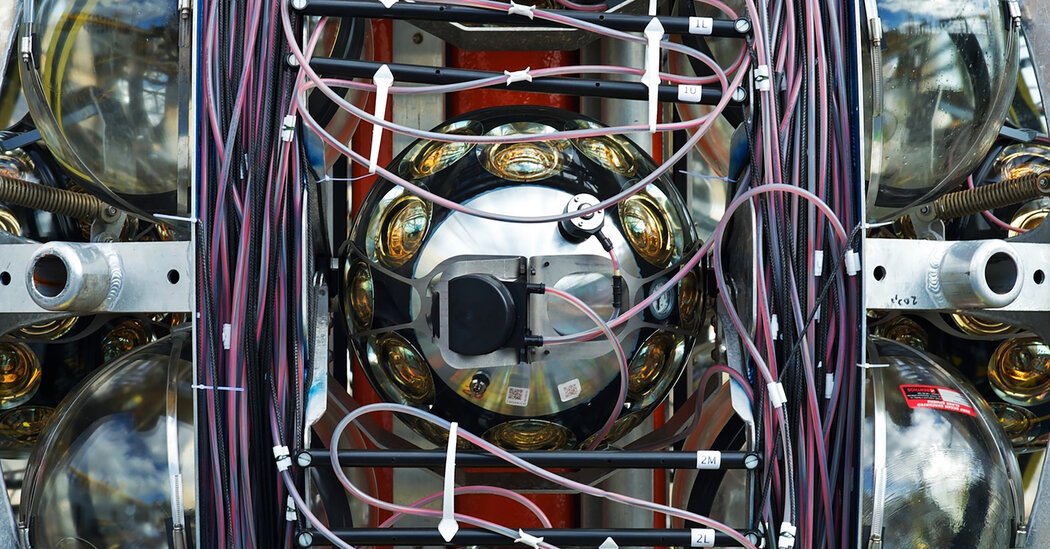At the bottom of the Mediterranean Sea waters, physicists discovered evidence of a ghostly subseomic particle catapulting through space at a speed of which they could only dream.
“What we have discovered is that we think, the most energetic neutrino ever recorded on earth,” said Paul de Jong, a physicist of the University of Amsterdam and the current spokesperson for the global collaboration of About 350 scientists who participated in the discovery.
The team announced its neutrino “Ultrahigh Energy” on Wednesday in a paper Published in La Revue Nature. The observation brings together physicists and astronomers to understand exactly what, exactly, pushes the particles at such unfathomable speeds.
At a press conference on Tuesday, researchers described discovery as an overview of what the universe looks like its most extreme. “We have just opened a whole new window,” said Paschal Coyle, an astrroparticular physicist at the Center for Particle Physics in Marseille in France. “It’s really a very exciting first overview in this energy diet.”
Neutrinos are notoriously anti -social. Unlike most other particles, they are almost weightless and have no electrical load, so that they have not regularly collided, do not repel or interact with matter. They circulate through almost everything – the bowels of the stars, the galaxies barattage dust, ordinary people – without trace.
Thus, without hindrance, the neutrinos point directly to their origins, which in fact of excellent guides to the natural “cosmic accelerators” which created them. They are also spectacular elusive, and for decades, scientists worked to trap them with instruments deeply in the mountains, under frozen lakes and buried in the Antarctic ice.
But no captured neutrinon was previously resembled it. Scientists have found the ultra-high energy neutrino using the neutrino-cube kilometer telescope, or km3net, which is still under construction but which already works. The instrument consists of a pair of detectors a few kilometers below the surface of the Mediterranean, off the coast of France and Sicily.
A detector – made up of light orbs strings, spaced the length of a football field and anchored in the seabed – was only built at 10% when a third of its sensors turned on with the flash characteristic of a neutrino observation.
The detector has not directly seen Neutrino. Rather, he picked up traces of a different subatomic particle, known as Muon, created when the neutrino came up against the rock or sea water nearby.
This muon has zipped through km3net at a quick speed, leaving a trace of bright blue photons in the otherwise dark abyss of the sea. Using the pattern of light, as well as the time of its arrival at different parts of the grid, The team deduced the management of the original Neutrino. They also estimated that the neutrino was carrying 220 million billion energy of energy.
It’s not bigger than the energy of a falling ping-pong ball. But the energy of a ping-pong ball is spread over a thousand billion particles. Here, tightened in one of the smallest spots in the material in our universe, this energy rose to tens of thousands of times more than that can be achieved by the first particle accelerator in the world, the Large collision of Hadrons at CERN.
The telescope recorded the Neutrino at Ultrahigh Energy in February 2023. But the researchers needed two years to interpret and analyze the data, during which they were sworn between exaltation and skepticism.
He “took some time to sink, to be honest,” Aart Heijboer, astronomer of Neutrino, told the National Institute of Subatomical Physics in the Netherlands. Another scientist said that the energy of the particle was so extreme that his total data had crushed his computer.
Before the discovery, the most energy neutrino ever detected was approximately 10 million billion electrolts. This file at the time, was established in 2014 by the Icecube Neutrinos observatory, an even larger grid of light sensors encrusted in the Antarctic ice.
It is rare that an instrument like Km3net detects a Netrino as extraordinary so early in his life, which added to the skepticism of the result. Erik Blaufuss, Icecube physicist at the University of Maryland who wrote a corresponding comment in nature On Wednesday, said it heard clues for the first time on discovery during conferences last summer. “I think there was a lot of disbelief that it might be real,” said Dr. Blaufuss. “In a decade of observations, we have not seen anything like it.”
Km3net was lucky, according to Naoko Kurahashi Neilson, an astrophysicist at Drexel University who is not officially in the telescope team but who has an observer status. “This is incredible proof that their detector works well,” she said, adding that detection of a neutrino alone “raises many more questions than he answers it.”
A large question is what type of cosmic accelerator could have generated such energetic particles. Perhaps a supermassive black hole devouring the gas and the dust that surrounds it. Or perhaps a cataclysmic explosion of gamma rays, the highest shape of energy in light, which occurs when the heart of a star launches on itself.
Such processes emit loaded particles that can crash into the neighboring matter, generating a wave of neutrinos that cross the cosmos and, sometimes, in telescopes on earth. Another theory is that these charged particles interact with the light left from the Big Bang, creating “cosmogenic” neutrinos which can transport secrets on the evolution of the universe.
The KM3NET team will endeavor to nail more precisely the management of the Neutrino, to better determine the origin of the particle. And as the telescope approaches completion in 2028, scientists hope that more comparable pep neutrinos could reveal themselves.
For Dr. de Jong, the discovery highlighted the importance of trying new types of detection, such as acoustics and radio Sension, which can be better able to catch neutrinos to ultra -high energies.
“Now we know that these neutrinos are not only predicted,” he said. “They are there. They are real. “”






